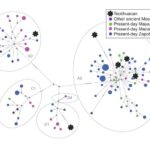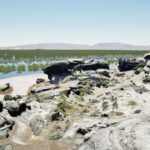Strong monsoons facilitated the dispersion of Homo sapiens to East Asia
The CENIEH participates in an international study showing that rainfall was a key factor in fostering the settlement of our species in new territories.
María Martinón Torres, director of the Centro Nacional de Investigación sobre la Evolución Humana (CENIEH), has participated in an international paper published in the journal PNAS which shows that the strengthening of the summer monsoon played a key role in the dispersion of Homo sapiens from Africa to East Asia during the interglacial between 70,000 and 125,000 years ago.
It is generally accepted that climatic variability had a fundamental impact on the evolution of our species and its dispersion out of Africa. However, our comprehension of the hydroclimatic influence on the early dispersion of H. sapiens has been limited by the lack of integration of the paleoclimatic and paleoanthropological data in Asia and, in particular, the effects of the summer monsoon there.
“This study integrates new high-resolution reconstructions of the behavior of the Asian summer monsoon based on continuous modeling of the East Asia hydroclimate, an exhaustive compilation of data from paleoanthropological sites, and a simulation of the habitat of H. sapiens which covers the last 280,000 years,” says Martinón Torres.
To reconstruct how the Asian summer monsoon has varied over the last 280,000 years, 2066 samples were collected from the Loess Plateau in central China. The resulting reconstructions, whose resolution is unprecedented, suggest that the variability of the Asian summer monsoon arose out of the combined action of changes in insolation, ice volume, and the concentration of greenhouse gases.
“When we integrated the paleoclimatic reconstructions with the paleoanthropological data compiled from Asia, we discovered to our surprise that our species dispersed into East Asia at the same time that the Asian summer monsoon strengthened. This suggests that the paleo-monsoon played an important role in the dispersion of H. sapiens from Africa to East Asia,”
states Hong Ao, lead author of the study, and a professor at the Institute of Earth Environment of the Chinese Academy of Sciences.
“The idea that the climate constrained the dispersions of hominins is not new, but we generally associate it with changes of temperature. We can now add the rainfall to this equation, as a factor that fostered the settlement of our species in new territories,” concludes Martinón Torres.
Changes in habitat
To furnish more quantitative evidence of the effects of climate on the dispersions of H. sapiens, another of the co-authors, Jiaoyang Ruan, who is a researcher at the Center for Climate Physics (ICCP) of the IBS (South Korea), analyzed computer simulations of the habitats of H. sapiens and discovered that the occupation of East Asia was consistent with a transcontinental rise in the simulated suitability of the habitat.
For his part, Thibaut Caley, another of the co-authors and a paleoclimatologist at the University of Bordeaux (France), considers that
“in contrast with the strengthening of the Asian summer monsoons, the climate across broad swathes of Southeast Africa deteriorated during the last interglacial. It is possible that the hydroclimatic changes in the two continents acted in tandem, stimulating both our departure from Africa and penetration into East Asia.”
Bibliographic information:
Ao, H., Ruan, J., Martinón-Torres, M., Krapp, M., Liebrand, D., Dekkers, M. J., Caley, T., Jonell, T. N., Zhu, Z., Huang, C., Li, X., Zhang, Z., Sun, Q., Yang, P., Jiang, J., Li, X., Xie, X., Song, Y., Qiang, X., Zhang, P., & An, Z. (2024). Concurrent Asian monsoon strengthening and early modern human dispersal to East Asia during the last interglacial. Proceedings of the National Academy of Sciences, 121(3), e2308994121, DOI: https://doi.org/10.1073/pnas.2308994121

Press release from the Centro Nacional de Investigación sobre la Evolución Humana – CENIEH



